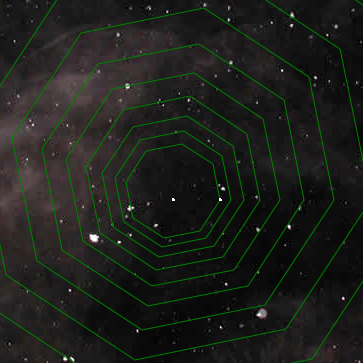Dr Who TN
Teacher Notes
 This is a really absorbing and engaging puzzle that is rich with interesting mathematical behaviour. The essential learning objective for this activity is about scale factors of enlargement and repeated enlargement. The medium for the challenge really appeals and this type of dynamic question represents a whole new genre of questions that is offered by technology. The image of space as the backdrop and the effect of disappearing down a tunnel are really cool and makes students really want to be able to do it for themselves. To do so requires some critical mathematical thinking and problem solving. Students have to piece the observations together to make coherent explanations of what is happening and why it is happening before they can recreate it and it is here that the richness of this activity lies. I do seriously recommend that teachers try this for themselves before looking at the solution and discussion screencasts below! Its great fun and an excellent challenge!
This is a really absorbing and engaging puzzle that is rich with interesting mathematical behaviour. The essential learning objective for this activity is about scale factors of enlargement and repeated enlargement. The medium for the challenge really appeals and this type of dynamic question represents a whole new genre of questions that is offered by technology. The image of space as the backdrop and the effect of disappearing down a tunnel are really cool and makes students really want to be able to do it for themselves. To do so requires some critical mathematical thinking and problem solving. Students have to piece the observations together to make coherent explanations of what is happening and why it is happening before they can recreate it and it is here that the richness of this activity lies. I do seriously recommend that teachers try this for themselves before looking at the solution and discussion screencasts below! Its great fun and an excellent challenge!
How
The following is some practical advice about how the activity might be run.
Making the animation
The following screencast shows how the Dr Who animations were put together using dynamic geometry software.
Geogebra
Cabri Geometre
Resources needed
Students will need access to computers and dynamic geometry software for this activity. Obviously computers can be shared, but one to a computer is probably preferable in this case. The resources for this activity were created with Cabri Geometry but are equally possible with other alternatives.
Time needs
As ever, this is variable and probably driven by how much time is available! It could be a quick starter to a lesson or an in depth project lasting a couple of lessons. This depends how the teacher wants to present the problem.
Starting and Finishing
- My favourite way to start this activity is to ask the open question 'Can you recreate this animation?' and let students start making conjectures as soon as possible!
- Students can be shown the videos one at a time or given all three from the start
- There are some key points to try and bring out of the discussion at some point during the lesson and they are outlined below.
Key Points
The following screencast outlines some of the points to consider whilst looking at the animations. A summary is written below.
- Why are there lots of shapes?
- How are they changing?
- What is not changing?
- What mathematics describe the way they are changing?
- What are the possible variables in the scenario?
- Where does the second pattern come from and why?
Records
If time allows, then it is fantastic if students can create their own animations based on the principles in this activity. These can be kept by students or posted on Youtube or the school website for example and students will show them off proudly to others.
Related Activities
This is part of a series of similar activities for transformations.
![]() Kaleidoscope - Playing with repeated rotation
Kaleidoscope - Playing with repeated rotation
